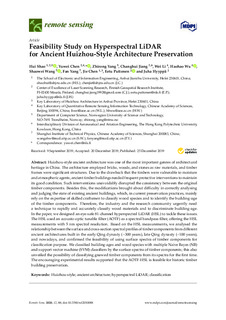| dc.contributor.author | Shao, Hui | |
| dc.contributor.author | Chen, Yuwei | |
| dc.contributor.author | Yang, Zhirong | |
| dc.contributor.author | Jiang, Changhui | |
| dc.contributor.author | Li, Wei | |
| dc.contributor.author | Wu, Haohao | |
| dc.contributor.author | Wang, Shaowei | |
| dc.contributor.author | Yang, Fan | |
| dc.contributor.author | Chen, Jie | |
| dc.contributor.author | Puttnon, Eetu | |
| dc.contributor.author | Hyyppä, Juha | |
| dc.date.accessioned | 2020-01-23T08:44:00Z | |
| dc.date.available | 2020-01-23T08:44:00Z | |
| dc.date.created | 2019-12-27T21:38:45Z | |
| dc.date.issued | 2020 | |
| dc.identifier.citation | Remote Sensing. 2020, 12 (1), 88-103. | nb_NO |
| dc.identifier.issn | 2072-4292 | |
| dc.identifier.uri | http://hdl.handle.net/11250/2637571 | |
| dc.description.abstract | Huizhou-style ancient architecture was one of the most important genres of architectural heritage in China. The architecture employed bricks, woods, and stones as raw materials, and timber frames were significant structures. Due to the drawback that the timbers were vulnerable to moisture and atmospheric agents, ancient timber buildings needed frequent protective interventions to maintain its good condition. Such interventions unavoidably disrupted the consistency between the original timber components. Besides this, the modifications brought about difficulty in correctly analysing and judging the state of existing ancient buildings, which, in current preservation practices, mainly rely on the expertise of skilled craftsmen to classify wood species and to identify the building-age of the timber components. Therefore, the industry and the research community urgently need a technique to rapidly and accurately classify wood materials and to discriminate building-age. In the paper, we designed an eye-safe 81-channel hyperspectral LiDAR (HSL) to tackle these issues. The HSL used an acousto-optic tunable filter (AOTF) as a spectral bandpass filter, offering the HSL measurements with 5 nm spectral resolution. Based on the HSL measurements, we analysed the relationship between the surface and cross-section spectral profiles of timber components from different ancient architectures built in the early Qing dynasty (~300 years), late Qing dynasty (~100 years), and nowadays, and confirmed the feasibility of using surface spectra of timber components for classification purpose. We classified building-ages and wood species with multiple Naive Bayes (NB) and support vector machine (SVM) classifiers by the surface spectra of timber components; this also unveiled the possibility of classifying gnawed timber components from its spectra for the first time. The encouraging experimental results supported that the AOTF-HSL is feasible for historic timber building preservation. | nb_NO |
| dc.language.iso | eng | nb_NO |
| dc.publisher | MDPI | nb_NO |
| dc.relation.uri | https://doi.org/10.3390/rs12010088 | |
| dc.rights | Navngivelse 4.0 Internasjonal | * |
| dc.rights.uri | http://creativecommons.org/licenses/by/4.0/deed.no | * |
| dc.title | Feasibility Study on Hyperspectral LiDAR for Ancient Huizhou-Style Architecture Preservation | nb_NO |
| dc.type | Journal article | nb_NO |
| dc.type | Peer reviewed | nb_NO |
| dc.description.version | publishedVersion | nb_NO |
| dc.source.pagenumber | 88-103 | nb_NO |
| dc.source.volume | 12 | nb_NO |
| dc.source.journal | Remote Sensing | nb_NO |
| dc.source.issue | 1 | nb_NO |
| dc.identifier.doi | https://doi.org/10.3390/rs12010088 | |
| dc.identifier.cristin | 1764027 | |
| dc.relation.project | Norges forskningsråd: 287284 | nb_NO |
| dc.description.localcode | © 2019 by the authors. Licensee MDPI, Basel, Switzerland. This article is an open access article distributed under the terms and conditions of the Creative Commons Attribution (CC BY) license (http://creativecommons.org/licenses/by/4.0/). | nb_NO |
| cristin.unitcode | 194,63,10,0 | |
| cristin.unitname | Institutt for datateknologi og informatikk | |
| cristin.ispublished | true | |
| cristin.fulltext | original | |
| cristin.qualitycode | 1 | |

